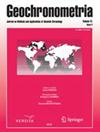Revision of the human’s occupations chronologies at the Senegalese and Mauritania sites by using marine reservoir ages corrections
IF 0.9
4区 地球科学
Q3 Earth and Planetary Sciences
引用次数: 0
Abstract
Abstract The prehistoric settlement of the west coast of the Senegalese-Mauritanian basin is established from archaeological remains and coal samples collected, sometimes in a stratigraphic context. However, the chronology issued, in the Before Present (BP) age, does not take into account the taphonomic context of the sites and the local reservoir age. Therefore, this article revisits the chronologies obtained based on the 14C literature and dating(s) acquired. Changes in time and duration of human occupancy of the area are shorter or longer depending on adequate yields of local reservoir age (Ndeye, 2008), which is a relevant element for marine samples. Thus, the archaeological implications observed with the reservoir effect are the rejuvenation or ageing of the dates, the age of the sites, the duration of occupation prehistoric or historical sites studied. Using the calibration programmes, it is noted that for the site of Senegal (Khant), without taking into account the reservoir effect, the human occupation is a priori, from the fifth millennium (Ancient Neolithic) to the third millennium BC (Middle Neolithic). However, if this marine reservoir effect is applied, the chronological periodisation goes from the fourth millennium to the first millennium. For the Mauritanian sites, the reservoir age correction is necessary for the Chami site while for the Tintan site is not required. Therefore, the calibrated archaeological chronologies obtained after the application of the marine reservoir effect are more relevant.利用海洋水库年龄修正塞内加尔和毛里塔尼亚遗址的人类职业年表
塞内加尔-毛里塔尼亚盆地西海岸的史前定居点是根据考古遗迹和收集的煤炭样本建立的,有时在地层学背景下。然而,在距今(BP)时代发布的年代学并没有考虑到这些遗址的地理环境和当地的储层年龄。因此,本文回顾了基于14C文献和所获得的年代测定所获得的年表。人类在该地区居住的时间和持续时间的变化取决于当地水库年龄的足够产量(Ndeye, 2008),这是海洋样本的一个相关因素。因此,通过水库效应观察到的考古意义是日期的恢复或老化,遗址的年龄,史前或历史遗址被占领的时间。使用校准程序,可以注意到,对于塞内加尔(汗特)遗址,不考虑水库效应,人类的占领是先验的,从公元前第五千年(新石器时代古代)到公元前第三千年(新石器时代中期)。然而,如果应用这种海洋水库效应,则时间周期从第四个千年到第一个千年。对于毛里塔尼亚的遗址,查米遗址的水库年龄校正是必要的,而廷坦遗址则不需要。因此,应用海洋水库效应后得到的校正考古年表更具有相关性。
本文章由计算机程序翻译,如有差异,请以英文原文为准。
求助全文
约1分钟内获得全文
求助全文
来源期刊

Geochronometria
地学-地球科学综合
CiteScore
2.20
自引率
0.00%
发文量
1
审稿时长
>12 weeks
期刊介绍:
Geochronometria is aimed at integrating scientists developing different methods of absolute chronology and using them in different fields of earth and other natural sciences and archaeology. The methods in use are e.g. radiocarbon, stable isotopes, isotopes of natural decay series, optically stimulated luminescence, thermoluminescence, EPR/ESR, dendrochronology, varve chronology. The journal publishes papers that are devoted to developing the dating methods as well as studies concentrating on their applications in geology, palaeoclimatology, palaeobiology, palaeohydrology, geocgraphy and archaeology etc.
 求助内容:
求助内容: 应助结果提醒方式:
应助结果提醒方式:


